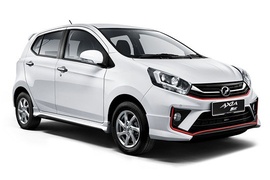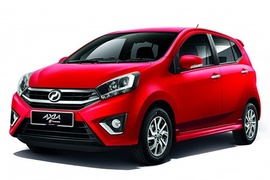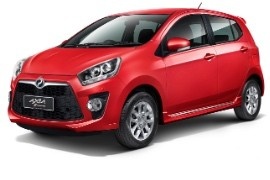
PERODUA Axia
Generations Timeline, Specs and Pictures

Perodua introduced the Axia on the Malaysian market in 2014 and facelifted the model twice, in 2017 and 2019, to keep the car fresh on the market.
The 2019 Axia came with more improvements in 2019 and added functional and aesthetic features to make it more appealing to the customers. It was also one of the most affordable cars on the market. Perodua didn’t design the car by itself. It was, in fact, a rebadged Daihatsu Ayla with some restyled elements.
At the front, the carmaker installed a grille above the bumper and a trapezoidal-shaped one in the apron. On the sides, a pair of scoops hosted the fog lights. The angled and angular shaped headlights featured signature C-shaped daytime running lights. On the sides, the full-option version came with power retractable and adjustable mirrors. An aerodynamic kit with body-colored side sills made the car looks sportier.
Perodua installed an ADAS (Advanced Driving Assistant System) with autonomous braking and pedestrian protection on the Axia. It was the cheapest car on the market to feature that safety equipment. Inside, the dashboard was short and featured a three-curves-shaped instrument cluster where the speedometer took center-stage flanked on the sides by the tachometer on the left and an LCD on the right. It offered room enough for four adult-sized passengers and a trunk that could carry 260 liters (9.2 cu-ft) of luggage.
Under the hood, Perodua installed a 1.0-liter three-cylinder engine that provided just 68 hp. It was paired as standard to a five-speed manual, while a four-speed automatic was on the options list.

Just three years after introducing the Axia nameplate on the market, Perodua considered that a facelift would increase its smallest vehicle sales.
In 2014, the Axia was the cheapest car on the Malaysian market and remained the same even after the 2017 facelift. While it was a badge-engineering car based on the Toyota Ayla, it still managed to get a very low price not only for what it offered but generally speaking.
With the 2017 facelifted version, the Malaysian carmaker tried to look much different than the Toyota or Daihatsu models, with which it shared its platform and most of the body panels. At the front, there was a new hood with two profiled lines on it. The designers offered a new, angular-shape for the headlights. They installed two chromed, horizontal slats with raised endings on the grille while the bumper sported side-scoops where the carmaker placed the fog lights. In the rear, a roof-spoiler adorned the top of the raked-forward tailgate.
The Axia featured a key-less entry system with a rubber button mounted on the driver’s door handle. Inside, the dashboard featured an Android Auto-compatible infotainment system that filled the center stack’s top. For the driver, the carmaker installed a three-curves instrument cluster with the speedometer in the middle flanked by the tachometer on the left and an LCD on the right. The Axia offered room for four adults and 260 liters (9.2 cu-ft) of luggage.
Under the hood, Perodua installed a 1.0-liter inline-three engine developed by Daihatsu. It was paired as standard to a five-speed manual, while a four-speed automatic was on the options list.

At the time of the launch, the Axia was the most affordable car on the Malaysian market.
The little car was unveiled in 2014 and it was the tenth model developed by Perodua.
The Malaysian car company had to replace the aged model Viva with something new, fresh, and appealing for the local market, but it didn’t want to risk anything. So, instead of developing a new product, it bought the license for a Daihatsu Ayla, a car that was already known in the area since it was produced in Indonesia.
The Axia featured a simple body design, with a very short hood, tall greenhouse, and an almost vertical rear end. The headlights were more aggressive for the top of the range SE version than on the base model. The front bumper featured a big, trapezoidal, grille for the SE and a smaller, smiling face for the base model. The SE was too aggressive for its class. But it featured 14” light-alloy wheels instead of the standard steel ones for the base version. In the back, there were LED taillights.
Inside, the top version featured AC, an infotainment unit with a touch-screen on the center console. A clear instrument cluster and nice leather-wrapped steering wheel were part of its equipment. The base model though, featured manual windows, no power lock, no radio and no speakers in the doors. It was just a basic mobility vehicle. The power steering was electric.
Under the hood, there was one engine option with a three-cylinder, one-liter unit. It offered just enough power to move the vehicle around. The standard transmission was a 5-speed manual, while a 4-speed automatic was offered as an option.























































